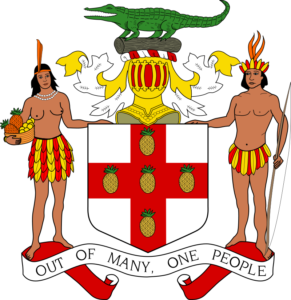orders of chivalry
jamaica
Described by Christopher Columbus as the fairest isles that eyes have eve beheld, Jamaica, has a rich history owing to the many immigrants that have settled here over the centuries. Jamaica, well known for its tropical beauty, reggae music, island life, and cuisine, also features impressive historical structures built by the colonial powers of Spain and Britain.
Brief history of the nation
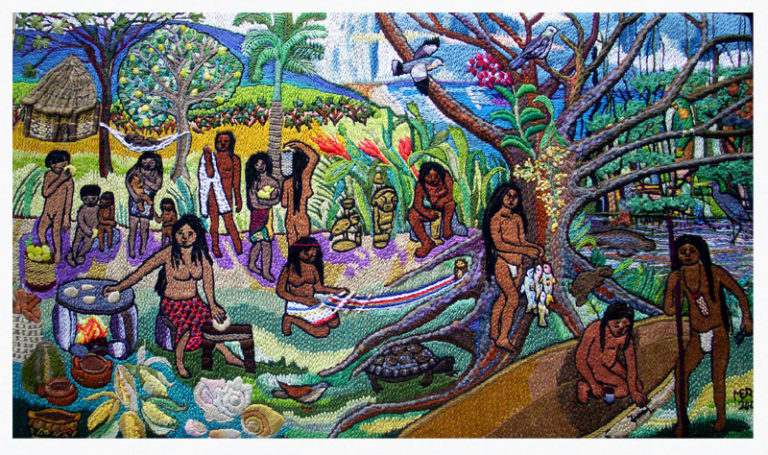
artwork depicting the ancient taino people of jamaica
Christopher Columbus, who first sighted the island in 1494, called it Santiago, but the original indigenous name of Jamaica, or Xaymaca, has persisted. Columbus considered it to be “the fairest isle that eyes have beheld,” and many travelers still regard it as one of the most beautiful islands in the Caribbean. The island’s various Spanish, French, and English place-names are remnants of its colonial history. The great majority of its people are of African ancestry, the descendants of slaves brought by European colonists. Jamaica became independent from the United Kingdom in 1962 but remains a member of the Commonwealth.
Jamaica, island country of the West Indies. It is the third largest island in the Caribbean Sea, after Cuba and Hispaniola. Jamaica is about 146 miles long and varies from 22 to 51 miles wide. It is situated some 100 miles west of Haiti, 90 miles south of Cuba, and 390 miles northeast of the nearest point on the mainland, Cape Gracias a Dios, on the Caribbean coast of Central America. The national capital is Kingston.
Spanish colonists had virtually exterminated the aboriginal Taino people by the time the English invaded the island in 1655. The Spaniards themselves escaped the island or were expelled shortly afterward. The population of English settlers remained small, but they brought in vast numbers of African slaves to work the sugar estates. Today the population consists predominantly of the descendants of those slaves, with a small proportion of people of mixed African and European descent. Even fewer in number are people who trace their ancestry to the United Kingdom, India, China, the Middle East, Portugal, and Germany.
Jamaica’s economy relies heavily on tourism, which has become one of the country’s largest sources of foreign exchange. Significant Spanish investment in the early 21st century joined U.S. and local capital in the tourist sector. Most tourists remain on the island for several days or weeks, although increasing numbers disembark only briefly from cruise ships at Ocho Rios, Montego Bay, and Falmouth. Those and other towns on the northern coast, as well as Kingston, are the tourist sector’s main bases of activity. Jamaica is famous for its pleasant climate, fine beaches, and superb scenery, including the waters of Montego Bay and the majestic Blue Mountains.
port royal
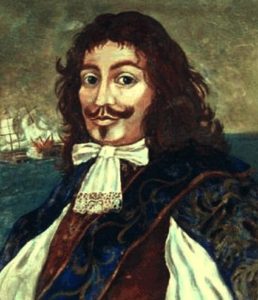
Henry morgan: pirate and Lt. Governor of jamaica
One of the oldest and most historic regions of the country, Port Royal has maintained much of its independence as well as its heritage. Once the enclave of pirates and other outlaws, there is still a strong seafaring tradition. Much of the old city, described in the 17th century as the “wickedest city in the west”, lies underwater beside the town, the result of an earthquake that in 1692 swallowed about two-thirds of the then-living space. Since then, another earthquake in 1907, numerous hurricanes, fires, and various population-decimating diseases have plagued the town. Despite all, the waters around Port Royal are a virtual archaeological gold mine, filled with pieces of history that tell of everyday life in the earliest days of English occupation. Port Royal is also home to the Archaeological Division of the Jamaica National Heritage Trust (JNHT), which recently completed a sonar survey of the underwater city, revealing a sunken pirate ship in the Kingston Harbor. To date thousands of artefacts have been recovered, and there are plans to develop a local museum to showcase these items once the research on them is complete.
The English and their pirate friends were relatively new to the area. Jamaica had been held by the Spanish since Columbus first declared it “the fairest island eyes have beheld” in 1494. Lacking gold or other obvious exploitable wealth, the Spanish held it but did not focus much energy there. It came under English power in 1655, after Cromwell sent English raiders to invade and capture the Spanish stronghold at Hispaniola (now Haiti and Dominican Republic, then the center of Spanish trade in the Caribbean). Cromwell’s men failed spectacularly at taking Hispaniola and turned to Jamaica as a second choice, better-than-nothing option.
Located on the southeast coast of Jamaica, the natural harbor at Port Royal became the center of English life in Jamaica. By the late 1600s it had become one of the largest European cities in the new world, second only to Boston. It had also become the infamous home of pirates, sex workers, and Englishmen on the make. Far from home, they made their livings off of the slave trade, slave labor in plantations, and the money that the pirates brought in from their looting forays against the Spanish.
It may be seen as an indicator of the caliber of vice in Port Royal that in 1675 the notorious pirate Henry Morgan became the Lieutenant Governor. In fact, Morgan began to crack down on overt piracy as the grand era of privateering he had been part of began to enter its waning phase. He died just four years before the earthquake struck and was buried in the Palisadoes cemetery.
On the morning of June 7, 1692, a massive earthquake estimated at a 7.5 magnitude hit the island. The city, largely built over sand, suffered instantly from liquifaction, with buildings, roads, and citizens sucked into the ground. Geysers erupted from the earth, buildings collapsed, and finally the city was hit by tsunami waves, dragging what had not been destroyed out to sea. In the end, some 33 acres of the city disappeared under water, four of the five forts were destroyed or submerged, and 2000 people were killed. The cemetery where Captain Morgan was buried slipped into the sea, its bodies floating up to mix with the freshly dead.
As news spread of the destruction of Port Royal, it was picked up as a cautionary tale and a sure sign of divine retribution for the lewd behavior of the pirates and sex workers, the pretensions and wealth of the gentry of the town, or the sins of slavery, depending on the city and the audience.
But at any rate, the earthquake did not end Port Royal’s wicked ways, nor its relationship with vice or with pirates who continued to stop by for another 50 years while they preyed on Spanish ships. In fact, in 1720, John “Calico Jack” Rackham was hanged at Gallows-Point in Port Royal by order of pirate hunter—and former privateer—Woodes Rogers (best known for his rescue of the castaway Alexander Selkirk, the inspiration for Robinson Crusoe).
culture
Jamaican culture is a product of the interaction between Europe and Africa. Terms such as “Afro-centred” and “Euro-centred,” however, are often used to denote the perceived duality in Jamaican cultural traditions and values. European influences persist in public institutions, medicine, Christian worship, and the arts. However, African continuities are present in religious life, Jamaican Creole language, cuisine, proverbs, drumming, the rhythms of Jamaican music and dance, traditional medicine (linked to herbal and spiritual healing), and tales of Anansi, the spider-trickster.
reggae music
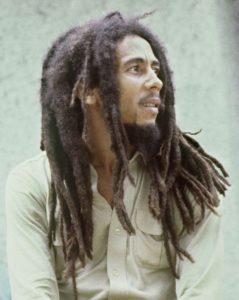
bob marley
Reggae is a style of popular music that originated in Jamaica in the late 1960s and quickly emerged as the country’s dominant music. By the 1970s it had become an international style that was particularly popular in Britain, the United States, and Africa. It was widely perceived as a voice of the oppressed.
Reggae evolved from earlier forms of music developed in Jamaica and bore the weight of increasingly politicized lyrics that addressed social and economic injustice. Among those who pioneered the new reggae sound were Toots and the Maytals, who had their first major hit with “54-46 (That’s My Number)” (1968), and the Wailers—Bunny Wailer, Peter Tosh, and reggae’s biggest star, Bob Marley—who recorded hits at Dodd’s Studio One and later worked with producer Lee (“Scratch”) Perry. Another reggae superstar, Jimmy Cliff, gained international fame as the star of the 1972 movie The Harder They Come. A major cultural force in the worldwide spread of reggae, this Jamaican-made film documented how the music became a voice for the poor and dispossessed. Its soundtrack was a celebration of the defiant human spirit that refuses to be suppressed.
During this period of reggae’s development, a connection grew between the music and the Rastafarian movement, which encourages the relocation of the African diaspora to Africa, deifies the Ethiopian emperor Haile Selassie I (whose pre-coronation name was Ras [Prince] Tafari), and endorses the sacramental use of ganja (marijuana). Rastafari (Rastafarianism) advocates equal rights and justice and draws on the mystical consciousness of kumina, an earlier Jamaican religious tradition that ritualized communication with ancestors. Besides Marley and the Wailers, groups who popularized the fusion of Rastafari and reggae were Big Youth, Black Uhuru, Burning Spear (principally Winston Rodney), and Culture. “Lover’s rock,” a style of reggae that celebrated erotic love, became popular through the works of artists such as Dennis Brown, Gregory Issacs, and Britain’s Maxi Priest.
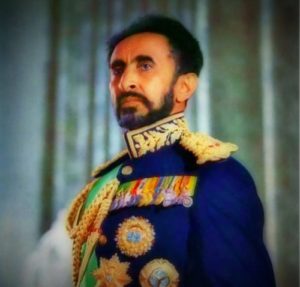
former Ethiopian Emperor Haile Selassie
popular attractions
Jamaica is a paradise offering many activities, whether it is dozing on the beach or hiking up a mountain, exploring underwater worlds, or visiting historical and cultural sites. Many visitors choose to hike daredevil waterfalls, drive along scenic hillside corridors, watch the gentle native crocodiles on a river safari, or take a trolley through historic towns. playing a round of golf. Some popular attractions in Jamaica include: Dunn’s River Falls and Turtle River Falls in Ocho Rios, the beaches in Negril, the Blue Lagoon in Port Antonio, as well as the scenic Blue Mountains.
Cuisine
Jamaican cuisine includes a mixture of cooking techniques, flavors and spices influenced by American Indian, African, Irish, English, French, Portuguese, Spanish, Indian, Chinese, and Middle Eastern people who have inhabited the island. It is also influenced by the crops introduced into the island from tropical Southeast Asia. All of which are now grown locally in Jamaica. A wide variety of seafood, tropical fruits and meats are available.
Some Jamaican dishes are variations on cuisines brought to the island from elsewhere. These are often modified to incorporate local produce and spices. Others are novel or fusion and have developed locally. Popular Jamaican dishes include curry goat, fried dumplings, and ackee and saltfish. Jamaican patties along with various pastries, breads and beverages are also popular.
Jamaican cuisine has spread with emigrants from the island to other nations, and has become favored cuisine in many areas.
the commonwealth of nations
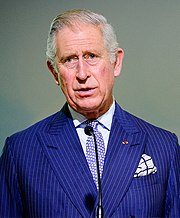
His majesty charles iii
The Commonwealth of Nations, generally known simply as the Commonwealth, is a political association of 54 member states, almost all of which are former territories of the British Empire. The chief institutions of the organization are the Commonwealth Secretariat, which focuses on intergovernmental aspects, and the Commonwealth Foundation, which focuses on non-governmental relations between member states.
The Commonwealth dates to the first half of the 20th century with the decolonization of the British Empire through increased self-governance of its territories. It was originally created as the British Commonwealth of Nations through the Balfour Declaration at the 1926 Imperial Conference and formalized by the United Kingdom through the Statute of Westminster in 1931. The current Commonwealth of Nations was formally constituted by the London Declaration in 1949, which modernized the community and established the member states as “free and equal”.
The Head of the Commonwealth is currently King Charles III. The King is the head of state of 16 member states, known as the Commonwealth realms, while 33 other members are republics and 5 others have different monarchs.
Member states have no legal obligations to one another but are connected through their use of the English language and historical ties. Their stated shared values of democracy, human rights and the rule of law are enshrined in the Commonwealth Charter and promoted by the quadrennial Commonwealth Games.
The countries of the Commonwealth cover more than 11,566,870 sq mi, equivalent to 20 percent of the world’s land area. The total population is estimated to be 2,418,964,000 as of 2016, equivalent to nearly a third of the global population, making it the second largest intergovernmental organization by population behind the United Nations.
prime minister
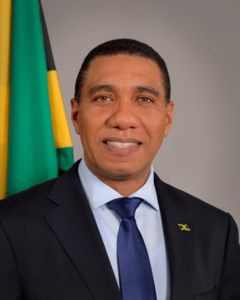
the most honorable Andrew Holness, prime minister of jamaica
The Most Honorable Andrew Michael Holness was first elected as Member of Parliament (MP) to represent the Constituency of West Central St. Andrew in 1997, at the age of 25. Now in his fourth consecutive term as MP, Mr. Holness became Jamaica’s ninth Prime Minister after the Jamaica Labour Party defeated the People’s National Party at the polls on February 25, 2016. Mr. Holness has pledged to build real partnerships with the Private Sector, Civil Society, the Diaspora, the Opposition and International Partners in order to achieve the vision of shared prosperity for all Jamaicans through inclusive economic growth and meaningful job creation.
Mr. Holness first served as Head of Government from October 2011 to January 2012 having succeeded former Prime Minister the Honourable Bruce Golding.
The governor general
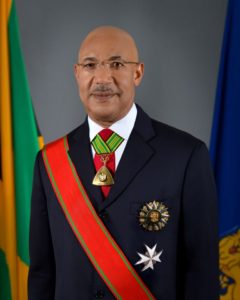
Sir patrick allen, governor-general of jamaica
The Governor-General of Jamaica is appointed by Her Majesty The Queen on the advice of the Prime Minister, within the monarchical system of Government provided by the Jamaican Constitution.
The Governor General is the defacto Head of State in Jamaica as Her Majesty has vested all executive authority in Jamaica to the Governor-General who at his installation takes the Oath of Office as prescribed by the constitution to function in her stead.
The Governor-General is appointed in accordance with Section 27 of the Jamaica Constitution (1962), which states “There shall be a Governor-General of Jamaica who shall be appointed by Her Majesty and shall hold office during Her Majesty’s pleasure and who shall be Her Majesty’s representative in Jamaica”.
The current Governor-General of Jamaica is Seventh-day Adventist pastor, Sir Patrick Linton Allen ON GCMG CD KStJ.
The fourth of five children in a family of subsistence farmers, Sir Patrick spent over a decade as a teacher and principal, before leaving education to be trained as an Adventist minister at Andrews University in the United States. After becoming a pastor, he went on to serve in a number of leadership roles within the Seventh-day Adventist Church, eventually becoming the leader of the West Indies Union of Seventh-day Adventists, which had jurisdiction over Jamaica, The Bahamas, the Cayman Islands, and the Turks and Caicos Islands.
Sir Patrick became Jamaica’s sixth appointed governor-general (eighth overall, including two acting governors-general). He replaced Sir Kenneth O. Hall, who resigned for health reasons.
Jamaican Honors and Awards System
The National Honors and Awards Act, promulgated on the 18th of July 1969, made it possible for the nation to recognize those who, by their service and contribution, have had a meaningful and significant impact on national life. The National Honors and Awards are administered by the Chancery of the Orders of the Societies of Honor within the Office of the Prime Minister.
Formal recognition of service to Jamaica and its citizens may be given by the conferment of the Honor of one of the Orders of the six Societies of Honor, three badges of honor, or four medals of honor established under the provisions of the National Honors and Awards Act.
SOCIETIES OF HONOR
ORDER OF THE NATIONAL HERO
The Order of National Hero is the most senior Order of the awards system. The honor of the Order of National Hero may be conferred upon any person who was born in Jamaica or is, or at the time of his or her death was, a citizen of Jamaica and rendered to Jamaica service of a most distinguished nature. A member of the Order is entitled to be styled “Right Excellent” (which may be abbreviated to Rt. Excellent) and the motto of the Order is “He built a city which hath foundations”.
The insignia of the Order of National Hero consists of a gold and white enameled star of fourteen points, the center of which shows the heraldic Arms of Jamaica in gold on a black enameled medallion.
This is surrounded by the motto of the Order in gold lettering on green enamel. The collar badge is suspended from a black, gold and green neck riband by a gold and green enameled laurel wreath.
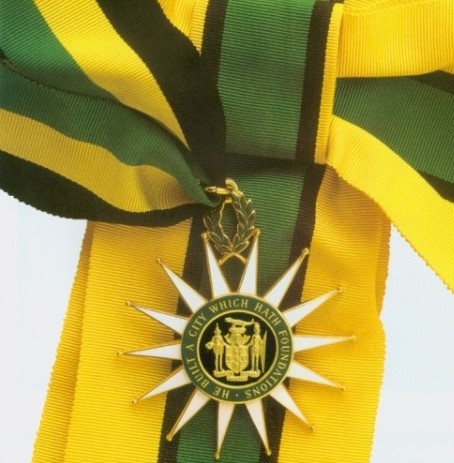
ORDER OF THE NATION
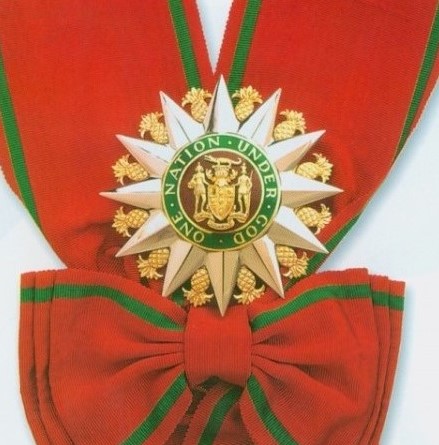
The honor of the Order of the Nation (ON), the second most senior order of the awards system, may be conferred upon any Governor-General of Jamaica or upon any person who has been appointed as Prime Minister of Jamaica, not being a person upon whom the honor of the Order of National Hero has been conferred. Members of the Order are styled “the Most Honorable” and the spouse of the member is also entitled to be so styled. Members of the Order are entitled to place the letters “ON” after their name. The motto of the Order is “One Nation under God”.
The insignia of the Order of the Nation consists of a magnificent breast star bearing the heraldic Arms of Jamaica on a red enameled background in the center and surrounded by the motto of the Order in gold lettering on green enamel. Between the points of the star are gold representations of pineapples. The broad watered silk sash is in a brilliant red with narrow green edging.
ORDER OF EXCELLENCE
The honor of the Order of Excellence (OE) is ranked equally, in the order of precedence, with the honor of the Order of the Nation and may be conferred upon any foreign Head of State or foreign Head of Government, and upon any foreign former Head of State or foreign former Head of Government. Members of the Order are styled “The Most Honorable” and are entitled to place the letters “OE” after their name. The motto of the Order is “Excellence through Service”.
The insignia of the Order of Excellence is a twelve-pointed breast star in yellow gold, interspersed with representations of pineapples in white gold. In the center is the Coat of Arms of Jamaica in yellow gold, superimposed on a red enameled background and surrounded by the motto of the Order in gold letters on royal blue enamel. It is worn with a yellow shoulder sash edged with a narrow band of green and black in equal proportions.
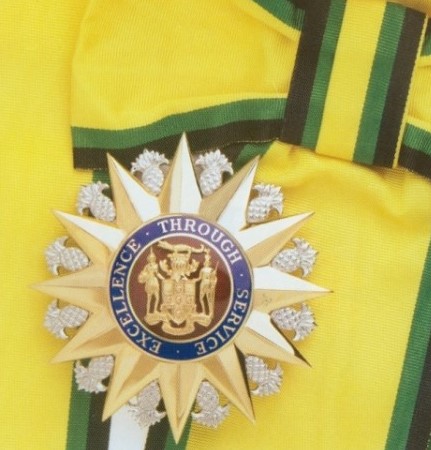
ORDER OF MERIT
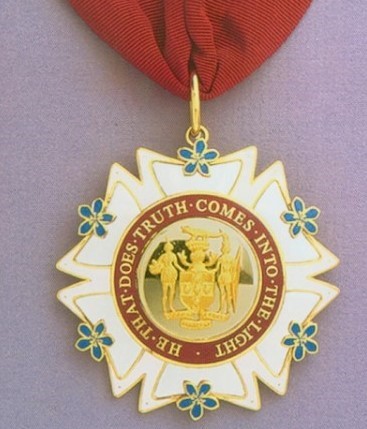
The honor of the Order of Merit (OM), ranked third in order of Precedence within the awards system, may be conferred upon any citizen of Jamaica or distinguished citizen of a country other than Jamaica (an honorary member) who has achieved eminent international distinction in the field of science, the arts, literature or any other endeavor. It is not conferred upon more than two persons in any one year. Members of the Order are styled “Honorable” and are entitled to place the letters “OM” after their name. The motto of the Order is “He that does truth comes into the light”.
The insignia of the Order of Merit is also a collar badge suspended from a deep maroon silk riband. The six-armed white enameled star with twelve points has superimposed on it a lesser shaped star in silver. Between each of the outer six points of the star is the blue Lignum Vitae flower of Jamaica. In the center is the Coat of Arms of Jamaica in gold on a contrasting silver background, surrounded by the motto of the Order in gold lettering on red enamel.
ORDER OF jAMAICA
The honor of the Order of Jamaica (OJ), ranked fourth in the order of precedence within the awards system, may be conferred upon any Jamaican citizen of outstanding distinction or upon any distinguished citizen of a country other than Jamaica (honorary member). Members of the Order are styled “Honorable” and are entitled to place the letters “OJ” after their name. The motto of the Order is “For a covenant of the People”.
The insignia of the Order of Jamaica is made in solid gold and consists of a white enamel collar badge, the ends of which represent the ackee fruit and leaves, suspended from a deep green silk riband. The center shows the heraldic Arms of Jamaica against a gold background and this is surrounded by the gold lettered motto of the Order on green enamel.
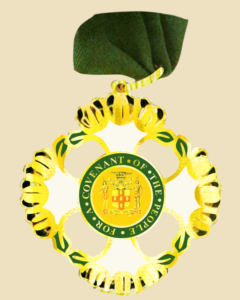
ORDER OF DISTINCTION
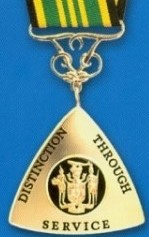
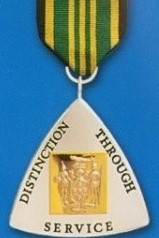
The Order of Distinction has two ranks, namely Commander and Officer. The Order may be conferred upon any citizen of Jamaica who renders outstanding and important services to Jamaica and upon any distinguished citizen of a country other than Jamaica (an honorary member). The motto of the Order is “Distinction through Service”.
The insignia of the Commander of the Order of Distinction is a triangular badge with curved sides. In the center is a black medallion bearing the Arms of Jamaica in gold. The words of the motto of the Order are in black. The Badge is suspended from a silk collar riband of black, gold and green by a silver finial of two intertwined letters “J” attached to the uppermost point of the triangle. Commanders of the Order are entitled to place the letters “CD” after their name.
The insignia of the Officer of the Order of Distinction (Officer) is suspended from a breast riband of similar colors without the finial. The triangular silver badge has in the center a yellow enameled square on which are placed the Arms of Jamaica in silver. Officers of the Order are entitled to place the letters “OD” after their name.
BADGES OF HONOR
The Badge of Honor may be awarded to civilian residents of Jamaica and to foreign nationals who are employed in Jamaica’s Diplomatic and Consular Missions overseas in the following three categories:
- Gallantry – awarded to persons who have performed acts of gallantry or acts of heroism or who have shown great courage in circumstances of extreme danger.
- Meritorious Service – awarded to persons who have rendered loyal and meritorious service beneficial to Jamaica
- Long and Faithful Service – awarded to persons who have rendered long and valuable service worthy of special recognition.
The Badge of Honor is made of silver and is circular in design bearing on the obverse the Arms of Jamaica, the word “Jamaica” and Lignum Vitae leaves and flowers around the border; and on the reverse the words “For Gallantry”, “For Meritorious Service” or “For Long and Faithful Service” as the case may be.
By regulation approved by The Governor-General in July 1996, holders of the abovementioned Badges of Honor are entitled to place the following letters after their names:
- Badge of Honor for Gallantry – BH(G)
- Badge of Honor for Meritorious Service – BH(M)
- Badge of Honor for Long and Faithful Service – BH(L)
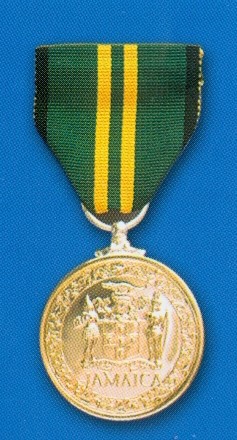
mEDALS OF HONOR
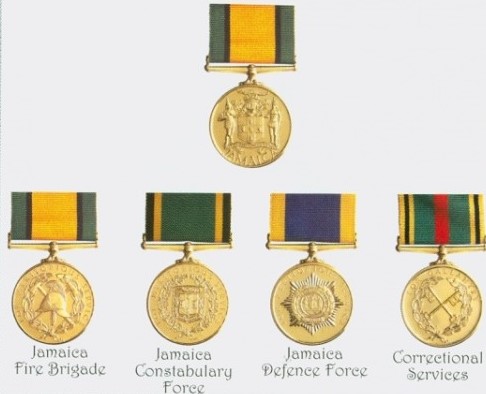
The Medal of Honor may be awarded to officers and other members of the Jamaica Defense Force (JDF), Jamaica Constabulary Force (JCF), Island Special Constabulary Force (ISCF), Department of Correctional Services (DCS) and Jamaica Fire Brigade (JFB) for Gallantry, Meritorious Service, General Service (JDF only), Long Service and Good Conduct, and Efficient Service (for the National Reserve of the
JDF and ISCF only). Awards to the Uniformed Services may be made on the recommendation of the Head of each Service.
Recipients of the Medal of Honor for Gallantry are entitled to place the letters “MG” after their name.
Medal of Honor – Jamaica Defense Force (JDF)
The Medal of Honor is awarded in the following categories:
- Gallantry
- Meritorious Service
- General Service
- Long Service and Good Conduct
- Efficient Service
This section was produced with the assistance and permission of the Chief of State for Protocol & Secretary-General of the Chancery of the Societies of Honour; Chancery & Protocol Division. One of the most beautiful countries of the world, Jamaica has a lot to offer. The island fascinates travelers with its rich history, eclectic culture, the surreal scenery, and friendly citizens. Anyone interested in visiting Jamaica, is highly encouraged to visit one of the many sites promoting tourism to this unique and beautiful country.Those interested in learning more about the Jamaican Honors and Awards System chivalric orders are encouraged to visit their webpage at https://opm.gov.jm/publications/jamaican-honours-and-awards-system/.
